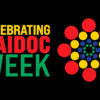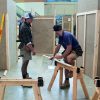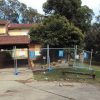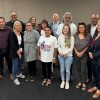Meet a PSA member making the planet a better place.
On the scale of job satisfaction, releasing a critically endangered turtle into the wild must rate very highly.
Daniel Cain is Senior Project Officer Threatened Species with the Department of Planning and Environment’s Saving our Species program.
“My role is implementing conservation projects in the Mid North and Far North Coast of NSW,” said Mr Cain, who has worked in the NSW Public Sector since 2010 and on this program for about six years. “Those conservation projects range from long-nosed potoroos, which are small marsupials, to Bellinger River snapping turtles, which is a freshwater turtle that is critically endangered, as well as some flora projects.
“The past two years, I have been working on bushfire recovery projects with commonwealth and state funding. We have seen some good outcomes working with community, with private landholders and other government agencies and non-government organisations.”
A PSA Delegate since 2010, Mr Cain is part of a team working to ensure species do not vanish from the planet forever.
“The Bellinger River snapping turtle is critically endangered,” said Mr Cain. “It suffered a mass mortality event around eight years ago when about 90 per cent of the population died as the result of a virus.
 “Since then, we have been working with Taronga Zoo and Symbio Wildlife Park and many other stakeholders and researchers to monitor the population that exists in the river and captive-breed some juvenile turtles with the aim of releasing them back into the wild.”
“Since then, we have been working with Taronga Zoo and Symbio Wildlife Park and many other stakeholders and researchers to monitor the population that exists in the river and captive-breed some juvenile turtles with the aim of releasing them back into the wild.”
In the past few years, he has contributed to the release of 82 of the critically endangered turtles into the Mid North Coast river system, something he describes as “the most rewarding project I have worked on”.
Mr Cain and his team keep tabs on the turtles released into the wild, measuring and weighing them regularly to monitor their progress. This is a part of his job he particularly enjoys.
“Imagine snorkelling all day, diving for turtles then releasing them knowing they are safe for another year,” he said.
The understandable desire of people to live near the NSW coastline is a contributing factor to the pressure on another species Mr Cain works with. However, his work is aided with information from people whose ancestors have lived alongside the animal for tens of thousands of years.
“The long-nose potoroo is listed as vulnerable in NSW and federally,” said Mr Cain. “Its main pressure is development up and down the coast.
“It ranges from Southeast Queensland down to Tasmania, but it lives in very discrete, isolated pockets. The patch I am working on is with the Indigenous Rangers at the Ngunya Jargoon Indigenous Protected Area.”
Ngunya Jargoon Indigenous Protected Area covers more than 1100 hectares of the Lower Richmond Valley.
Preventing species from extinction is not the sole preserve of national parks, state forests and other protected areas, with privately held land a large part of the habitat for Australian animals.
 “Private landholders have a huge role to play in caring for the landscape,” said Mr Cain. “By looking after their own patch, whether it is a small rural holding or a large valley, everybody plays a part in preserving our natural heritage.”
“Private landholders have a huge role to play in caring for the landscape,” said Mr Cain. “By looking after their own patch, whether it is a small rural holding or a large valley, everybody plays a part in preserving our natural heritage.”
He recommends land holders in the Mid North and Far North Coasts should look at the NSW Saving Our Species part of the www.environment.nsw.gov.au website and learn what they can do for biodiversity in the region.
“You can look up what species are in your area, what you can do for those species, what threats you can mitigate,” he said. Private owners can, for example, control foxes on their land or leave dead trees standing to create habitat for native species.
Mr Cain said anyone wanting to work protecting species needs to be passionate about the environment, resilient, up for early starts and late finishes and “they have got to want to leave the world in a better place than when they found it”.
















Leave a Comment
Your email address will not be published. Required fields are marked with *